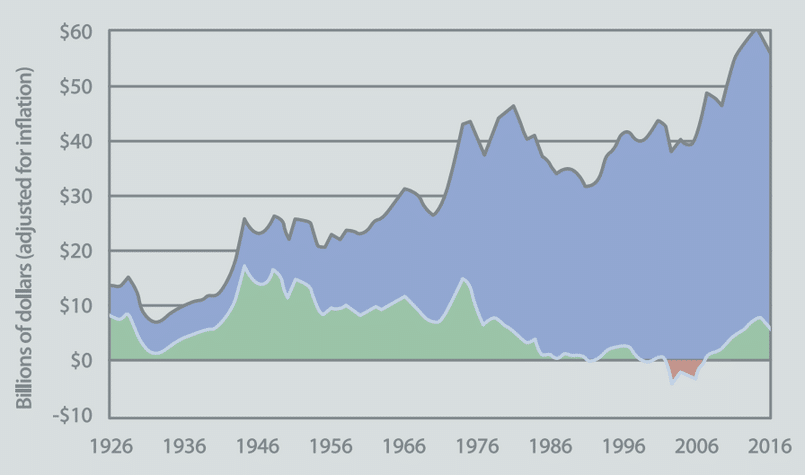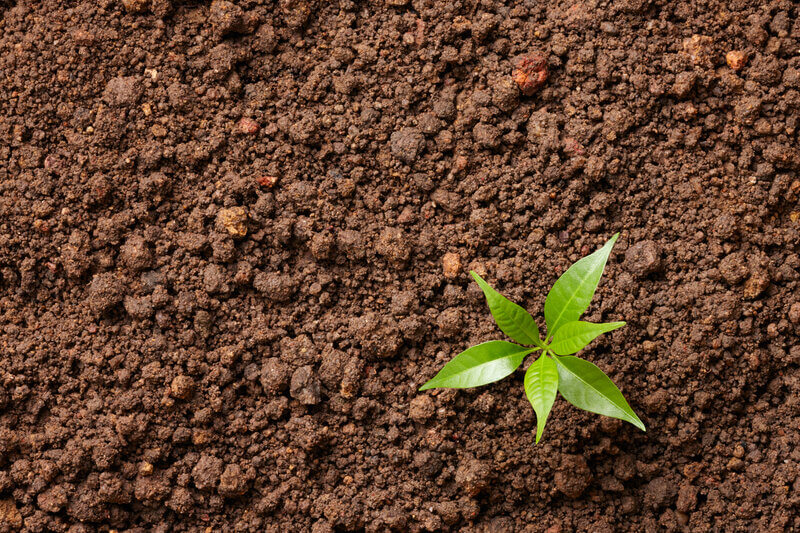Have we lost sight of the fact that nature did very well without our intervention and that soil sustained life without inputs for millennia?
With the interruption to the supply chain for agricultural chemicals caused by the recent invasion of Ukraine by Russia, we have seen large increases in the cost of agricultural products. Now is a great time to look to nature to learn how to farm without expensive and harmful inputs.
The modern farming dependency on inputs
Modern farming practices have become increasingly dependent on inputs. The conspiracy view is that this is driven by big business to create greater opportunity for profit from servicing the farming industry. There may be some validity to this view if you consider the consequence of this approach to farming profit.
The graph below shows that gross output from farms has increased steadily over decades (blue area), but since the 80s these returns don’t go to the farms and profits (green area) suffer.

I feel this is more a demonstration of how the industrial farming model has changed our behaviour. We have become conditioned to expect that if we apply these commonly accepted practices/interventions we will improve agricultural productivity even to the point that if we don’t use these interventions we will fail and go broke. We are hard-wired to predictability.
But nature is not predictable. It is a living system, not a machine, and as a living system has the potential to self-maintain and self-regenerate. It doesn’t need constant feeding.
But we are now dependent on these interventions and use them without question to the cost of our own profits. Have we lost sight of the fact that nature did very well without our intervention and that soil sustained life without inputs for millennia?
Has modern agriculture disrupted our soil?
The soil was created from rock through the mining carried out by fungi working with all the other teeming life in healthy soils – bacteria, viruses, protozoa, arthropods, and worms. This critical interdependence and connection that supports life have been disrupted by modern agricultural practices, especially the working of soils, biocides, and many fertilisers in common practice.
We have become conditioned to spend a high percentage of our income on these synthetic products which we do every year and get no closer to self-reliance. The more we intervene, the more we disrupt the interconnections that provide natural resilience and become more dependent on costly inputs.
Many of the farming practices which have become normalised work against the very conditions required to sustain life and health. Synthetic fertilisers damage soil biology. Many of the sprays used have antimicrobial properties which kill large numbers of the species forming critical collaborations in the soil, and many of the unwanted infestations of ‘weeds’ and ‘bugs’ are unintended consequences of interfering with the predator-prey relationships within the soil.

A new way of thinking with regenerative design
By bringing regenerative design to the management of land, using holistic decision making and holistic management tools we reduce this dependence on inputs and start to benefit from the unrealised potential within soils.
Healthy soil is a living system and only living systems have the ability to self-maintain and self-regenerate.
There is a global change in consumer preference showing up strongly in buying habits. Regenerative sourcing of products is now driving decision making in many large global brands and organisations. This is starting to show up in New Zealand farms and many are starting to adopt these regenerative practices. Consumer led opportunities are now changing from the commodity model.
To farm with nature, we need to create the conditions for the life in the soil to thrive.
It’s time to work with nature
I have now completed EOV on many farms across the country. A common finding is compacted soils with very limited capacity to withhold water and very shallow roots. If we are to move away from our heavy annual dependence on inputs, we need to change this soil state to improve the water holding capacity and encourage stronger root activity. In return, this will allow the build-up of organic matter in the soil – deeper – and the sequestration of carbon.
While agriculture is showing up as part of the problem, it is also the biggest opportunity for New Zealand to change its environmental and climate impact. It has already been the industry that has carried us through the last few turbulent years.
Regenerative is working with and learning from nature – we don’t have to control it, we don’t even know how it works. Let’s stand beside and work with it, not against it so we all benefit.
So, the question is – can we farm without fertiliser?
Yes, we can.

Work with us for a regenerative future
We work with farmers to help with regenerative adoption and implementation and can help you to transition to a regenerative future.
There is no pre-qualification required, no pre-conditions for entry and no pressure to achieve beyond the level of your own progress, just a genuine desire to change towards a system that can deliver health to the planet and people and secure a long-term future for humanity on earth.
Regenerative is a movement, that is transforming farming, agriculture, communities, business, and organisations.
Contact us for more information about how we can help you or visit our home page to start your regenerative journey.


